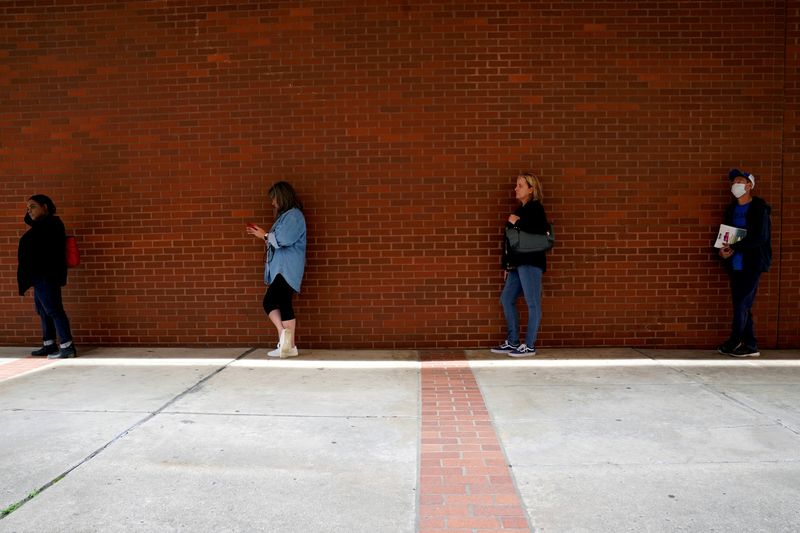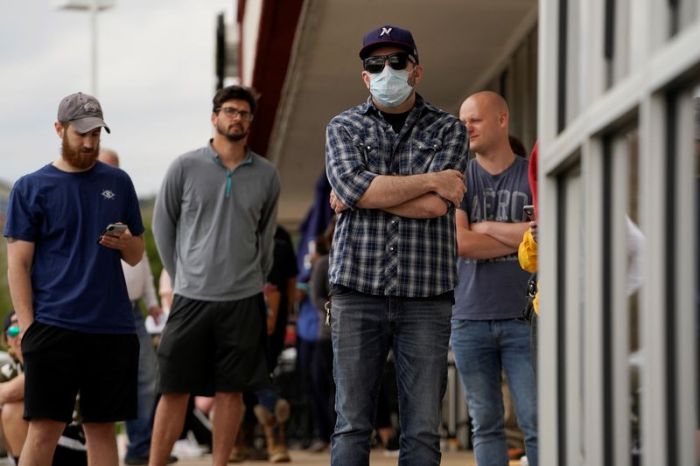SAN FRANCISCO (Reuters) – The U.S. economy shed 20.5 million jobs in April, and the unemployment rate rose to 14.7%, a government report Friday showed.
But these grim numbers — both slightly less horrible than economist expectations – don’t capture the staggering impact of the coronavirus pandemic on the workforce in the world’s largest economy.
The true unemployment rate may be closer to 19.5%, the government said in a note attached to its report.
And that figure does not even count people whose hours were cut sharply due to the virus, or who couldn’t look for work because of stay-at-home orders.
The unemployment rate is part of a monthly report from the federal government’s Labor Department, showing how many people don’t have jobs as a percentage of the overall American workforce. The “jobs report,” as the release is known, provides two important labor market yardsticks: that unemployment rate, generated by a survey of households, and nonfarm payrolls, from a survey of businesses.
The unemployment rate has long been an indicator of the health of the economy, shrinking when jobs are plentiful and rising when times get hard.
A 14.7% unemployment rate means that nearly 15 people out of every 100 who want work don’t have jobs. That is a lot more than the 4.4% rate in March.
But as many as 7.5 million unemployed people were probably misclassified in as being employed, the report said, and millions more wanted to work but were not even classified as being in the labor force.
Here is what the “jobless” report does and doesn’t show:
UNEMPLOYMENT INSURANCE CLAIMS
Many U.S. workers who lose their jobs are eligible for weekly payments to help tide them over until they find their next job.
These payments, which workers and employers fund, are known as unemployment insurance benefits. Some 33.5 million people have filed for them since mid March, when states first began imposing stay-at-home orders, weekly data published Thursday shows https://www.reuters.com/article/us-usa-economy/millions-more-americans-file-for-jobless-benefits-productivity-tanks-idUSKBN22J0HT.
That is about one out of every five workers in the United States.
But that doesn’t mean the economy has 33.5 million jobs fewer than it did then, because even during a severe recession, some employers – supermarkets or delivery truck drivers right now – are still hiring. There have been three jobs added for every 10 layoffs, a recent Atlanta Fed survey. (https://www.frbatlanta.org/blogs/macroblog/2020/05/01/covid-19-caused-3-new-hires-for-every-10-layoffs found)
The unemployment claims only count the layoffs. Friday’s report shows the net change in jobs.
The unemployment insurance claims do not reflect every job lost in the United States, because not everyone who loses their job is eligible for unemployment insurance. There have been long delays in some states for processing claims, and the claims do not count until they are processed.
Confusing matters further, businesses that got loans under the government’s $660 billion Paycheck Protection Program may have hired back some people who had previously filed for unemployment benefits. And some states such as California, the country’s largest by population and GDP, let people file an unemployment claim if their hours were cut, even if they did not “lose” their job.
THE UNCOUNTED
The Labor Department publishes six measures of unemployment, based on its survey of households (https://www.bls.gov/cps/cps_htgm.htm). The main one is technically called U-3, and to qualify you need to be both out of work and looking for a job to be counted. That is the one that rose to 14.7% on Friday.
A broader measure of unemployment, called U-6, captures people who are not counted in U-3, like those working fewer hours than they would like, or who looked for work in the past but just not recently.
Last month this rate jumped to 22.8%, from 8.7% in March.
Even that broader measure does not tell the whole story of who is not working right now.
While the unemployment rate is supposed to capture people furloughed due to the pandemic, the report said that many such people were misclassified as employed but just absent from work – a category that is usually very small and includes mostly people on parental leave or on vacation.
Adding back those people into the ranks of the unemployed, the report said, generates an unemployment rate of 19.5%, not 14.7%.
The unemployment rate also misses people who lost their jobs but cannot look for or do work because of stay-at-home orders to slow the spread of COVID-19. If you aren’t looking for work, you aren’t counted among the unemployed. The government noted there were 9.9 million people who wanted a job but were not counted in the labor force.
A pair of economists at the Chicago Fed recently crunched the numbers and found that accounting for such people could lift the real unemployment rate in the United States by several percentage points above and beyond the U-6. An immediate estimate of this higher number wasn’t yet available Friday.
(This story has been refiled to add missing word ‘number’ in last paragraph)
(Reporting by Ann Saphir; Editing by Heather Timmons, Daniel Wallis and Chizu Nomiyama)
























